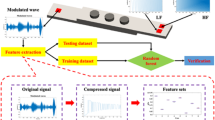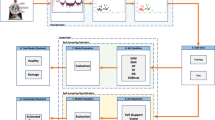Abstract
Given that traditional theoretical diagnosis is difficult to use for the accurate prediction of the looseness of bolted joints, this paper will use the support vector machine (SVM) method to solve this problem. The paper establishes a database by studying the loosening mechanism of bolted joints and by collecting the connection information of the fastening points of the vehicle chassis. Key influence features are determined by the information gain value. The average prediction accuracy of the standard SVM model is 76.94 %, which is better than the theoretical diagnosis method. To achieve optimization, the feature weighted support vector machine and the multiple kernel function support vector machine (MKL SVM) are established, and the average prediction accuracy is 82.18 % and 84.19 %, respectively. The fusion weighted support vector machine (FW-MKL SVM) is built by combining the advantages of two weighted optimization SVMs. The average prediction accuracy is 94.5 %, which meets practical engineering requirements.
Similar content being viewed by others
Abbreviations
- H IG :
-
Information gain value of feature A
- H C/A :
-
Information weighted sum of feature A
- F(x):
-
Optimal expression of linear separable problem
- P :
-
Linear transformation matrix
- λ :
-
Weight of kernel function
- V:
-
Particle optimal velocity
- X:
-
Optimal position of particle motion
- N:
-
Total number of samples
- P:
-
Accuracy rate
- R:
-
Recall rate
References
S. Y. Hou and R. D. Liao, Research status and development trend of bolted joints loosening process, Strength and Environment, 42(2) (2014) 39–52.
G. H. Junker, New criteria for self-loosening of fasteners under vibration, SAE Technical Paper Series, 78 (1969) 314–335.
N. Nishimura, T. Hattori, M. Yamashita and N. Hayakawa, Sliding and loosening behavior of thread joints under transverse loading, Key Engineering Materials, 84 (2007) 894–897.
N. Nishimura, T. Hattori, M. Yamashita and N. Hayakawa, Self -loosening behavior of metal thread joints under transverse cyclic loading, Key Engineering Materials, 63 (2007) 1467–1472.
Y. Y. Jiang, M. Zhang, T. W. Park and C. H. Lee, An experimental study of self-loosening of bolted joints, Journal of Mechanical Design, 126(5) (2004) 925–931.
N. G. Pai and D. P. Hess, Three-dimensional finite element analysis of threaded fastener loosening due to dynamic shear load, Engineering Failure Analysis, 9(4) (2002) 383–402.
N. G. Pai and D. P. Hess, Experimental study of loosening of threaded fasteners due to dynamics shear loads, Journal Sound & Vibration, 253(3) (2002) 585–602.
M. Y. Zhang, L. T. Lu, M. M. Tang and D. F. Zeng, Research on numerical calculation method of critical loose load of bolt under transverse load, Journal Mechanical Engineering, 54(5) (2018) 173–178.
H. Gong, J. H. Liu and X. Y. Ding, Study on the critical loosening condition toward a new design guideline for bolted joints, Proceedings of the Institution of Mechanical Engineers, 233(9) (2019) 3302–3316.
I. Ahmad, X. J. Wang, R. F. Li and S. Rasheed, Offline Urdu Nastaleeq optical character recognition based on stacked denoising autoencoder, China Communications, 14(1) (2017) 146–157.
C. Du, S. L. Zhou, J. X. Sun, H. Sun and L. L. Wang, Discriminant embedding by sparse representation and nonparametric discriminant analysis for face recognition, Journal of Central South University, 20(12) (2013) 3564–3572.
D. L. Yang, Y. L. Liu, S. B. Li, X. J. Li and L. Y. Ma, Gear fault diagnosis based on support vector machine optimized by artificial bee colony algorithm, Mechanism and Machine Theory, 90 (2015) 219–229.
Q. Yu, S. J. Jiang, R. C. Wang and H. Y. Wang, A feature selection approach based on a similarity measure for software defect prediction, Frontiers of Information Technology & Electronic Engineering, 18(11) (2017) 1744–1753.
Y. J. Chen and Y. T. Hao, A feature weighted support vector machine and K-nearest neighbor algorithm for stock market indices prediction, Expert Systems with Applications, 80 (2017) 340–355.
W. G. Wang and Z. S. Liu, Multi-objective particle swarm optimization support vector machine and its application in gear fault diagnosis, Journal of Vibration Engineering, 26(5) (2013) 743–750.
X. L. Tian, G. Gasso and S. Canu, A multiple kernel framework for inductive semi-supervised SVM learning, Neurocomputing, 90 (2012) 46–58.
L. B. Zhu, J. Hong, G. Q. Yang and X. J. Jiang, Experimental study on initial loss of tension in bolted joints, Proceedings of the Institution of Mechanical Engineers, Part C: Journal of Mechanical Engineering Science, 230(10) (2016) 1685–1696.
T. Sawa, M. Ishimura, H. Yamanaka and Y. Fukuba, Mechanism of Rotational Screw Thread Loosening in Bolted Joints Under Repeated Temperature Changes, ASME, San Antonio, Texas, USA (2007) 2856–2863.
B. D. Patil and M. Eriten, Effects of interfacial strength and roughness on the static friction coefficient, Tribology Letters, 56(2) (2014) 355–374.
B. A. Housari, A. A. Alkelani and S. A. Nassar, A proposed model for predicting clamp load loss due to gasket creep relaxation in bolted joints, Journal of Pressure Vessel Technology, 134(2) (2012) (021201) 1–5.
B. A. Housari and S. A. Nassar, Effect of the thread and bearing friction coefficients on the vibration-induced loosening of threaded fasteners, Journal of Vibration and Acoustics, 129(4) (2007) 484–494.
C. W. Schwingshackl, E. P. Petrov and D. J. Ewins, Measured and estimated friction interface parameters in a nonlinear dynamic analysis, Mechanical Systems and Signal Processing, 28 (2012) 574–584.
D. W. Pepper, L. L. Hamm and A. B. Kehoe, VDI-2230: systematic calculation of high duty bolted joints — joints with one cylindrical bolt, Verein Deutscher Ingenieure (2014).
J. B. Lu, W. D. Hu, H. Xiao and W. X. Yu, Novel cued search strategy based on information gain for phased array radar, Journal of Systems Engineering and Electronics, 19(2) (2008) 292–297.
Y. H. Wang, S. F. Tian and H. K. Huang, Feature weighted support vector machine, Journal of Electronic and Information Science, 31(3) (2009) 514–518.
M. N. Tang, S. J. Chen, X. H. Zheng, T. S. Wang and H. Cao, Sensors deployment optimization in multi-dimensional space based on improved particle swarm optimization algorithm, Journal of Systems Engineering and Electronics, 29(5) (2018) 969–982.
Acknowledgments
This project is supported by the local and overseas project of comparative research and application of fastener locking reliability of SAIC GM Wuling Automobile Co., Ltd.
Author information
Authors and Affiliations
Corresponding author
Additional information
Chuanbo Liu was born in 1972. He is an Associate Professor at Wuhan University of Technology. He received a Ph.D. degree from Wuhan University of Technology, China in 2009. His research interests include human-robot interaction, mechanical design and theory, and vehicle thermal management.
Yanzhao Zhu is currently a Master’s degree student at the School of Mechanical and Electrical Engineering of Wuhan University of Technology in Hubei, China. His research interests are the reliability research of automotive fasteners and the optimization of automotive windows.
Rights and permissions
About this article
Cite this article
Liu, C., Zhu, Y., Zhan, K. et al. Prediction of bolted joint looseness based on feature weighted-multiple kernel support vector machine. J Mech Sci Technol 35, 2407–2418 (2021). https://doi.org/10.1007/s12206-021-0512-5
Received:
Revised:
Accepted:
Published:
Issue Date:
DOI: https://doi.org/10.1007/s12206-021-0512-5




